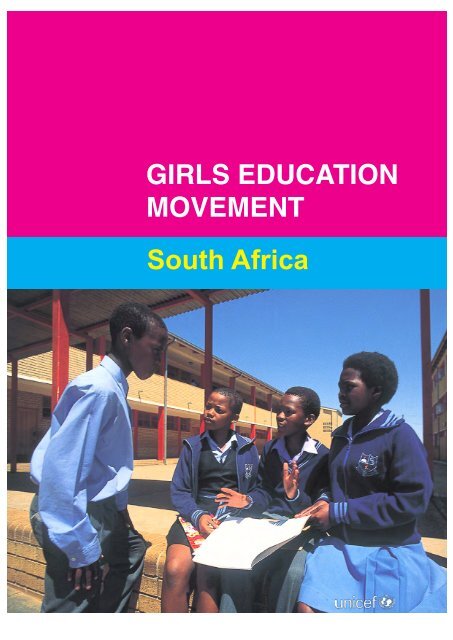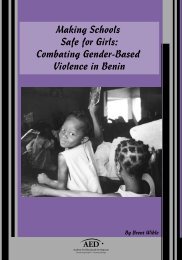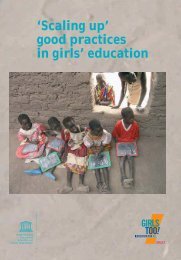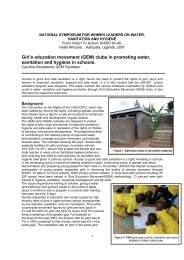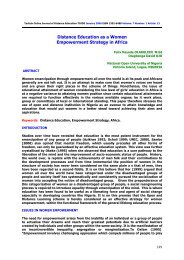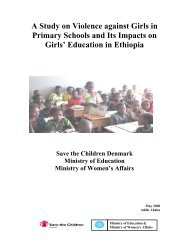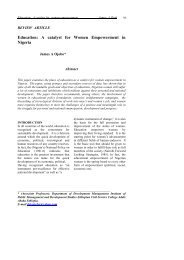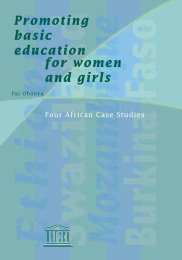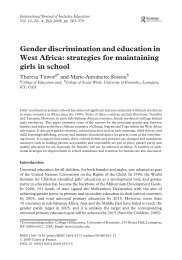GIRLS EDUCATION MOVEMENT South Africa
GIRLS EDUCATION MOVEMENT South Africa
GIRLS EDUCATION MOVEMENT South Africa
Create successful ePaper yourself
Turn your PDF publications into a flip-book with our unique Google optimized e-Paper software.
<strong>GIRLS</strong> <strong>EDUCATION</strong><strong>MOVEMENT</strong><strong>South</strong> <strong>Africa</strong>
ISSUEA better <strong>South</strong> <strong>Africa</strong>In today's <strong>South</strong> <strong>Africa</strong>, girls and boys stand abetter chance to develop and prosper. Sincethe birth of the new democracy in 1994, thecountry’s economy has grown significantly atan average of 4.5 percent and individual freedomand liberties have been vastly expanded.<strong>South</strong> <strong>Africa</strong> is now a middle-income economywith a strong emerging market, an abundantsupply of natural resources, well-developedfinancial, legal, communications, energy andtransport sectors and a stock exchange thatranks among the ten largest in the world. The<strong>South</strong> <strong>Africa</strong>n Constitution, built on an acuteawareness of the injustices of the past, iswidely regarded as the most progressive in theworld.Dashed hopes for manyThe prospect of a bright future is however outof reach for many of <strong>South</strong> <strong>Africa</strong>’s children.The country’s economic growth has not beenable to tame unemployment, which was estimatedat 25.2 percent in 2005. Daunting problemsremain from the apartheid era – especiallypoverty and the lack of economic empowermentfor <strong>South</strong> <strong>Africa</strong>ns from previouslydisadvantaged backgrounds.“Resources have been poured into schools inorder to ensure equal treatment. However, resourcesare not enough…research indicatesthat we are not seeing the outcomes in termsof quality education that were anticipated.”Government schools grapple with many challengesincluding a poor quality of education,high attrition rates, low teacher morale, thedevastating impact of HIV and AIDS, poor infrastructure,inadequate water and sanitationand poor mechanisms for inclusive educationparticularly for children with disabilities. Manylearners from poor families go to school hungry.Girls and young women still report highlevels of sexual abuse, harassment, exploitationand murder in their schools.FACTS & FIGURES96% of <strong>South</strong> <strong>Africa</strong>n children aged 7–13 areenrolled in primary education.70% of children aged 14–17 go to secondaryschool.9% of school-aged children repeat a grade inprimary school.In 2004/05, there were more than 55,000 reportedrapes in <strong>South</strong> <strong>Africa</strong>.40% of reported rapes were committedagainst children during 2004/05.10.2% of young <strong>South</strong> <strong>Africa</strong>ns aged 15–24are infected with HIV.Girls and women are four times more likely tobe HIV-positive than boys and men.Sources: UNICEF and the <strong>South</strong> <strong>Africa</strong>n Police Service.Key challenges to girls’ educationGender Inequality: <strong>South</strong> <strong>Africa</strong>n society is toa large extent patriarchal. Girls and women areaccorded lower social status and find themselvesunder the control and authority of men.The high levels of gender-based violence andthehigher HIV infection rates among girls andwomen are tragic consequences of female disempowerment.Girls are socialised to becomehome keepers and child-bearers, placing lessvalue on their educational attainment. Whengirls perform well in subjects such as maths orscience, they are not encouraged nor do theyhave the confidence to pursue careers that relyon these skills.Safety and Security: Many schools are notchild or girl friendly. Some are situated far fromhomes, exposing girls to danger when theywalk to and from school. Girls are at risk of beingsexually harassed and exploited in schoolsby teachers and fellow students.<strong>GIRLS</strong> <strong>EDUCATION</strong> <strong>MOVEMENT</strong> <strong>South</strong> <strong>Africa</strong> 1
The Report of the Public Hearing on the Rightto Basic Education states:“Of great concern were the accounts of teacherstaking advantage of their positions ofauthority and coercing sex from girls. An examplewas given of a learner coming late andhaving to exchange sex with a teacher in orderto be allowed onto the school premises thathad been locked.”The lack of separate school toilets for boys andgirls increases girls’ vulnerability to sexual violence.Teenage pregnancies, which are said tobe on the rise, are still stigmatised, making itdifficult for young mothers to continue theirstudies despite legislation that protects theirright to education.Impact of HIV and AIDS: Almost a million childrenunder the age of 15 have lost their parentsor caregivers to AIDS. Girls often drop outof school to look after sick family members andyounger siblings. Many teachers are succumbingto HIV and AIDS.Sexually active children and young people donot have sufficient access to testing, counselingand treatment because of the lack of accessto child and youth friendly health services.A culture of taboo and silence revolves aroundmatters such as sexuality, sex and reproductivehealth, making it difficult for children to get accurateknowledge to protect themselves.<strong>GIRLS</strong> <strong>EDUCATION</strong> <strong>MOVEMENT</strong> <strong>South</strong> <strong>Africa</strong> 2
ACTIONChildren doing it for themselvesIn 2003, the <strong>South</strong> <strong>Africa</strong>n Minister of Educationlaunched the Girls’ Education Movement(GEM) in Parliament. UNICEF supported theNational Department ofEducation to roll out GEMin all of the country’s nineprovinces.GEM is an <strong>Africa</strong>n childdrivengrassroots movementwhere children andyoung people in schoolsand communitiesthroughout the continentwork to bring positivechanges in the lives of<strong>Africa</strong>n girls and boys.GEM aims to:•!•!•!•!•!•!•!Give girls equalaccess to educationImprove the quality of education, especiallyin disadvantaged rural schoolsMake the school curriculum and schoolbooks gender responsiveCreate schools that are safe and securefor children, especially girlsWork with boys as strategic partnersReduce gender-based violenceAbolish harmful cultural practices suchas early marriage for girlsIt is now widely recognized that investments ingirls benefit the whole of society. Educated girlsbecome women who participate in the social,economic and political life of their nation. Educatedwomen are more likely to be healthy,have smaller families and to have healthy andeducated sons and daughters.A <strong>South</strong> <strong>Africa</strong>n flavourIn <strong>South</strong> <strong>Africa</strong>, GEM is a dynamic vehicle thatmobilises school communities to become moreresponsive to the needs and rights of the girlchild. It is integrated into a broader UNICEFand Government of <strong>South</strong> <strong>Africa</strong> ‘Child FriendlyA school is ‘child-friendly’, if it is:School Plus (CFS+)’ programme. The ‘plus’means that schools are also encouraged tobecome centres of careand support for orphansand other vulnerablechildren.Rights-basedAn important componentof the child-friendlyschool concept and GEMis training pupils in peereducation and life skills.In this way, schools becomea means of reachingthe wider communitywith information on howto prevent gender-basedviolence and HIV andAIDS, address drugabuse, discuss sexuality and stress the importanceof girls’ education.Gender responsiveEffectiveHealth seeking and promotingSafe and ProtectiveInclusiveWorks in partnership with the widercommunity, both public andprivateGiving children a voice and a chance to participatein decisions that will affect them at home,in school and the community at large contributesto building tremendous self-esteem andcourage through empowerment. Children aretherefore more likely to stand up for themselvesand take action against negative impactson their lives.A good example is the case of a 15 year-oldgirl in Limpopo who was married off to a mucholder man. She dropped out of school after themarriage. Her female classmates went to thehouse where she lived with the man andstarted chanting and singing for her to comeback to school. This went on for days until thehusband became so irritated that he called theyoung girl’s parents to take her back (storyshared with the author by Mary Monelela, DeputyChief Education Specialist, National Departmentof Education).Girls and boys uniteGEM is implemented through school-basedclubs. Clubs are not the exclusive domain ofgirls but include boys as ‘strategic partners’ ingender transformation. “I am my sister’skeeper” is what boys are encouraged to em<strong>GIRLS</strong> <strong>EDUCATION</strong> <strong>MOVEMENT</strong> <strong>South</strong> <strong>Africa</strong> 3
ace. With UNICEF support, more than 2,500learners and educators have been trainedsince 2002 as trainers in the theory and practiceof gender responsiveness that is fundamentalto GEM. They are in turn training peersin their schools on how to best work throughGEM.Since many schools already have extracurricularclubs, they are encouraged to incorporateGEM principles into existing activities. Differentschools interpret GEM in their own way andactivities are as varied. Examples of GEM activitiesinclude:•!•!•!Teams of girls and boys cleaning theirschool yard on a regular basis so anattractive learning environment is createdfor all,A suggestion box at school in whichchildren can anonymously report casesof sexual abuse,A drama group that performs skits,plays and songs on gender-relatedtopics.With support from UNICEF and input from students,teachers and parents, the Department ofEducation is designing training manuals, brochures,posters and pamphlets. These will beused to strengthen the positive impact GEM isalready having in many schools.There are also plans to expand GEM to includeexchange programmes with other <strong>Africa</strong>n countries.TechnogirlsThe Technogirls project supports and guidesgirls in making informed career and lifechoices, with an emphasis on professions usingmaths, science and technology. School girlsaged between 15 and 18 are drawn from previouslydisadvantaged communities, with participantsfrom rural areas are given priority.Learners come from public schools and areselected on the basis on their scholastic potential.They are placed in corporate companieswhere they undergo a mentoring and skills developmentprogramme with opportunities forscholarships.Technogirls further builds on and supports thevalues of GEM in that it aims to tap into thevalue of young women and allows them to excelin the previously male-dominated fields ofscience and technology. It creates a platformfor young girls to gain experience as interns incompanies and organisations that could supporttheir growth and development in theseareas. Technogirls therefore become the vehicleto realise the values of independence andgirls’ rights to achieve their maximum potentialin every social arena of their choice.<strong>GIRLS</strong> <strong>EDUCATION</strong> <strong>MOVEMENT</strong> <strong>South</strong> <strong>Africa</strong> 4
IMPACTGEM has placed girls’ education on theagenda of the <strong>South</strong> <strong>Africa</strong>n government.UNICEF was actively involved in establishingGEM in <strong>South</strong> <strong>Africa</strong> from the very start.UNICEF has developed a strong partnershipwith the National Department of Educationand has helped the department scaleup GEM to all nine of the country’s provincesby 2006.UNICEF is supporting 164 primary schoolsin Limpopo, KwaZulu Natal and the EasternCape to become ‘child friendly plus’.Many of these schools are also incorporatingGEM as part of their efforts to promotegirls’ education.GEM is seen as an effective way of respondingto the three inter-related threats togirls’ education in <strong>South</strong> <strong>Africa</strong> – genderinequality, violence in schools and the impactof HIV and AIDS.GEM encourages youth participation andempowerment. By giving children the opportunityto find solutions to problems affectingtheir lives, they become actors in the developmentof their schools, communities andnation.In a patriarchal society where girls do nothave full control over their bodies and lives,GEM is a vehicle for female empowerment.When girls acquire life skills and feelsupported by their peers and caring adults,they become confident enough to takecharge of their lives and put a stop to abuseand violence.Bringing boys on board as strategic partnersteaches both sexes that they can worktogether and not against each other to createa better <strong>South</strong> <strong>Africa</strong> for allThe Technogirls project gives girls broaderhorizons and shows them that they cansucceed in traditionally male-dominatedprofessions. To date, 34 ‘technogirls’ in theEastern Cape have been placed in miningcompanies and 20 girls will get scholarshipsto study mining.A Day in My LifeBy Fhulufhelo Jessica MamelasigidiGrade 10 student, Sandringham High School, Johannesburg‘A day in the life of a young <strong>South</strong> <strong>Africa</strong>n girl is not an easy task at all!’I wake up to a new day - with what I hope and aspire to accomplish that day. I get out of bed and wake upmy younger brothers and sisters and try to motivate them for the day ahead. Being the eldest girl in my family,it is my duty to prepare a healthy breakfast for all and make lunch for school for everybody. (Playing therole of caregiver.) I walk my younger brother and sister to crèche and only after that, when I am finally on myway to school, can I play the role of Jessica, “The Learner”.I am in a multi-racial class with classmates of different cultures, religions and backgrounds. My concentrationis fully focussed on the teacher, listening to every word he or she is saying. I sit in my seat striving toreceive the education my parents were deprived of, knowing I am a girl and it is against my tradition for afemale to attend school and be educated. However I sit in class holding my future in my heart, trying toovercome society and the prejudice that still exists against a young girl being educated.In each class a different teacher stands, each with a different gender, race, and culture. I try to show that Ias a young <strong>South</strong> <strong>Africa</strong>n woman am just as worthy to an education as the boy sitting next to me. My schoolis a good source of encouragement especially when it comes to its female learners. With the schools mottobeing “Factum non Verbum” (The deed not the word) I try to live by this motto and to perform the deed, and Iam encouraged to aim higher.<strong>GIRLS</strong> <strong>EDUCATION</strong> <strong>MOVEMENT</strong> <strong>South</strong> <strong>Africa</strong> 5
At the end of the school day I prepare my self for battle on the sports field. I persevere through the afternoonplaying my best trying to prove that sportswomen are just as good as sportsmen.I go home to play the role of ‘sis’ Jessica, in the late afternoon. I clean the house, fetch my younger brotherand sister from crèche and make sure I have started dinner before my mother gets home. I am alwayswanting to lash out at her and express what I really feel, wanting to tell her: ”NO I do not want to become awife, “NO, I do not want to become a mother, and ”NO, I do not want to become an employee at this age!” –Why doesn’t she just leave me to be educated and develop into the empowered women I want to be?Once my chores are done I start to do my homework, study for the test the next day and end up burning thecandle until mid-night.Tired, energy-drained and fatigued, I go to bed and pray to thy Father in Heaven. I get into bed and closemy eyes, I listen to the sound of drums beating in the distance and to the ancestors singing ” Mosadi wannete o aga lelapa” (a real woman should create a family) and slowly, slowlyI drift into a deep sleep…This essay is part of a UNICEF-sponsored Voice of Youth writing competition on gender, lifeskills and HIV and AIDS.<strong>GIRLS</strong> <strong>EDUCATION</strong> <strong>MOVEMENT</strong> <strong>South</strong> <strong>Africa</strong> 6
FUTUREACTIVITIESGEM is now part and parcel of the government’sstrategy for girls’ education and is a nationwideprogramme. GEM is set on course toforge more partnerships and increase dialoguebetween girls and boys, men and women,young and old, and different sectors of society.“We are pushing for GEM to become acommunity-based initiative,” says Mary Monelela,the Deputy Chief Education Specialist atthe National Department of Education.Future activities that will be supported byUNICEF include:An impact evaluation in August 2006 toprovide a basis for effective monitoring andevaluation of GEM.Bringing children from all provinces to participatein the national Gender in Educationconference in late August 2006.Conducting a snap audit of GEM in July2006 and creating a GEM database withvital indicators that can be used for trackingpurposes. The audit is currently underway.Supporting the national GEM camp in December2006 where children from all nineprovinces will be brought together to exchangeexperiences, receive further trainingand mobiles them to set up more GEMclubs.<strong>GIRLS</strong> <strong>EDUCATION</strong> <strong>MOVEMENT</strong> <strong>South</strong> <strong>Africa</strong> 7


